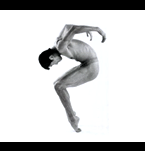
|
March 26, 2005 SALAD
FEST IS A TRIP IN SPACE AND TIME This year's Dance Salad Festival artists are from around the globe, but much of Thursday's program had powers of even further transport. Nacho Duato's 1990 masterpiece Por Vos Muero (For You I Die), performed by the Norwegian National Ballet, was a stellar time trip. An ode to the playful spirit of Spanish Renaissance folk and social idioms, the dance is set to a Garcilaso de la Vega poem. In spite of its clear geographic and period references, Por Vos Muero resides in some alternate universe of the mind. This is thanks to the way Duato's delightful, quirkily humanistic choreography plays out against a stunning Robert Wilson-ish set — two huge red drapes, pulled at the center, behind a folding screen with a shiny textured surface — and Duato's ingenious use of white masks on sticks. A scene of benediction, with a bevy of censer-wielding monks in lavender capes, is also magical. Jirí Kylián's Double You solo, danced with thrilling intensity by Netherlands Dance Theatre powerhouse Václav Kunes, got punch from a pair of pendulums swinging in opposite directions. There's no better wit in dance today than Kylián, a master of visual and verbal puns. The program suggests that Double You might be about present time. ("Yesterday is history, tomorrow is mystery, but today is a gift.") The pendulums made me think of a giant metronome, only seen through double vision. Kunes' sinuous moves sometimes mirrored their sway. And — maybe I'm layering too much on here — while the dance was made in 1994 and European Kylián doesn't have a president nicknamed "Dubya," I saw "W" imagery when Kunes ran upstage, parting the wings of the big red downstage curtain in his hands. A duet from Karole Armitage's newish Time Is the Echo of an Axe Within the Woods was coolly juxtaposed. Its silver-bead curtain made me think Kylián's pendulums had been blasted into shards and hung in space. Mod ballerina Megumi Eda was an electric presence, asserting her power like some galactic goddess through Armitage's smooth-sharp choreography. (A gold lamé leotard and Eda's severe brunet bob added to the image.) A shadowy controller, the magnetically statuesque William Issac, only slightly quieted her. Sets weren't the night's only mode of transport; some works flew on their organic relationship to music. Sections of Alonzo King's new Before the Blues got rivetingly under the score's skin. The ensemble finale, Blind, especially: Here King captured with bodies all the tension agitating under the melancholy, long-held jazz notes of Pharaoh Sanders' Rivers of Memory. King's choreography — and his dancers — were a marvel of sinuosity and strength. Time slowed thrillingly as lovely Yanni Yin of Ballet du Grand Théâtre de Genève channeled Vaslav Nijinsky in slow motion — and the operatic scale of Hector Berlioz's score — through her expressive arms in Michel Kelemenis' Kiki la Rose solo. Dominic Walsh Dance Theater's Bello had the night's only live music. Countertenor Gerrod Pagenkopf sang Handel's arias like an angel, while Walsh, Sara Webb and Paola Georgudis (all from Houston) poured emotion into the movement. Ballet de Monterrey's Huapango drew on a familiar Mexican tune. The dancers were smooth, charming and exuberant; but something was lost in translation with the fusion of ballet and folkloric. BJM Danse's XSpectacle, a fun and sleek urban jazz number, gave artistic integrity to moves inspired by Janet Jackson videos.
|
Copyright © 2005 Dance Salad. All rights reserved.